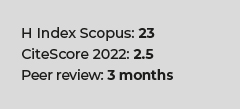Quantitative and qualitative analysis of Argentine breast cancer prevention campaigns disseminated by still images on social networks during October 2019
DOI:
https://doi.org/10.17843/rpmesp.2022.392.11019Keywords:
Breast Neoplasms, Mammography, Early Detection of Cancer, Communications Media, Health Knowledge, Attitudes, Practice, Social MediaAbstract
Objectives. To quantitatively document the degree of compliance of institutional messages broadcast on social networks with the recommendations of the National Cancer Institute (INC) in Argentina during October 2019, in the context of breast cancer prevention campaigns, and to qualitatively analyze the pictorial and textual elements that make up their dissemination pieces. Materials and methods. Quantitative and qualitative analysis of 171 dissemination pieces issued during October 2019 by 54 institutions, based on the evaluation of their compliance with INC recommendations, the description of the main discordant recommendations (quantitative analysis) and the qualitative analysis of 30 pieces. Results. None of the issued messages mentioned potential screening harms. Only the messages of the National Ministry of Health complied completely with the INC recommendations, while the remaining ones recommended mammograms at younger ages or at shorter intervals. Breast self-examination was the most frequent recommendation among those who didn’t comply. The images of female bodies linked to common stereotypes of sex and beauty, and paternalistic discourses appealing to fear and guilt were predominant. Conclusions. The messages broadcasted in the analyzed diffusion pieces did not comply with the INC recommendations, despite the fact that the latter are supported by scientific evidence. On the other hand, the messages reinforce sex and beauty stereotypes, guilt and the medical-hegemonic model.
Downloads
Published
Issue
Section
License
Copyright (c) 2022 Revista Peruana de Medicina Experimental y Salud Pública

This work is licensed under a Creative Commons Attribution 4.0 International License.


























